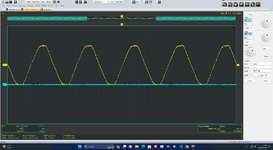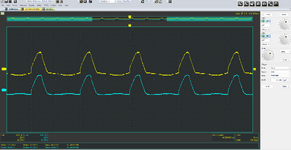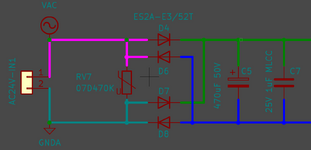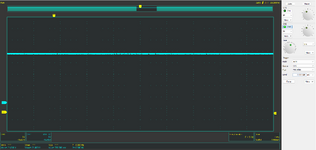avner_g
Junior Member level 2

So I decided I was going to design and build my first PCB and do (yet another) irrigation controller and moisture sensors.
First and foremost, it was great fun. Learning KiCAD, designing everything.
I made the design based on AC24V input (as the pumps require) and, a fairly simple and straightforward diode bridge, and 2 VRegs (to 5V and then 3V3). Here is it: https://github.com/theDontKnowGuy/sprinklers
However, it is not working as expected; the LM2596S-5 (datasheet) got hot in less than a minute to the level I couldn't touch it with my finger. Also a burn smell came out.
I quickly disconnected it and tried another board with AC12V. This time, it got very hot but took longer. Like 2 minutes.
I would appreciate it if you could take a peek at the design https://github.com/theDontKnowGuy/sprinklers to figure out which mistake we made.
I have made several measurements with my digital oscillometer, which I have also attached.
Someone suggested I run the feedback wire close to the inductor, which I did. I removed it and tried with a strad, but it didn't help either.
The main hint I have is that the over heating occurs also when I supply DC, not only AC.
What I am doing wrong???













First and foremost, it was great fun. Learning KiCAD, designing everything.
I made the design based on AC24V input (as the pumps require) and, a fairly simple and straightforward diode bridge, and 2 VRegs (to 5V and then 3V3). Here is it: https://github.com/theDontKnowGuy/sprinklers
However, it is not working as expected; the LM2596S-5 (datasheet) got hot in less than a minute to the level I couldn't touch it with my finger. Also a burn smell came out.
I quickly disconnected it and tried another board with AC12V. This time, it got very hot but took longer. Like 2 minutes.
I would appreciate it if you could take a peek at the design https://github.com/theDontKnowGuy/sprinklers to figure out which mistake we made.
I have made several measurements with my digital oscillometer, which I have also attached.
Someone suggested I run the feedback wire close to the inductor, which I did. I removed it and tried with a strad, but it didn't help either.
The main hint I have is that the over heating occurs also when I supply DC, not only AC.
What I am doing wrong???





